
This study tested whether one text message could prompt inactive voters to update their registration—and found modest but statistically significant improvements in Ohio.
- This study tested whether a single text message could prompt inactive voters to update their registration, using voter-provided numbers in Rhode Island and data-broker-sourced numbers in Ohio.
- In Rhode Island, at least 10% of texted voters updated their registration vs. 9% who didn’t—showing a performance boost.
- In Ohio, 5% of texted voters updated their registration vs. 4% of non-recipients, proving statistically significant outreach worked even with brokered data.
- These findings show that low-cost texts can effectively boost engagement and registration accuracy among hard-to-reach voters.
Abstract
This study evaluates the impact of text messaging interventions on voter registration updates in two scenarios: one involving unresponsive voters who provided phone numbers during registration, and another where phone numbers for unresponsive voters were obtained from external sources. In the lead-up to the 2024 U.S. presidential election, Rhode Island election officials reclassified 15,321 voters as inactive within the preceding two to twelve months. Of these, 24 percent (3,625 voters) had included text-capable phone numbers in their registration records. In Ohio, election officials identified 158,857 voter registrations for removal in August 2024, citing reasons such as death, relocation, or prolonged inactivity. Unlike in Rhode Island, Ohio voters had not provided phone numbers during registration. We obtained phone numbers from data brokers, using matches based on voters’ name, address, and year of birth. In both cases, a text message intervention was carried out, delivering a single message to hard-to-reach voters that encouraged them to update or confirm their registration through their respective state’s website in order to restore their active status.
Results summary:
In Rhode Island, at least 10 percent of 3,671 text recipients updated their registration within a month, compared to 9 percent of the remaining 11,650 inactive voters who did not receive a text. In Ohio, by Election Day, 5,403 voters (5 percent) who received the text message had updated their registration, compared to 1,468 voters (4 percent) who did not receive the message but nonetheless updated their registration. These modest improvements in Rhode Island, coupled with statistically significant results in Ohio among hard-to-reach and previously unresponsive voters, highlight the potential of text messaging interventions to meaningfully increase voter engagement—even when contact information is sourced externally.
Introduction
Voter list maintenance is a vital process carried out by election officials to uphold the integrity of voter rolls, as required by state election laws and the National Voter Registration Act (NVRA) [1]. This process typically involves removing individuals who are deceased, have moved out of the jurisdiction, or have become legally ineligible to vote—such as through incarceration. Although procedures vary across states, the underlying goal remains consistent: to safeguard the accuracy and reliability of elections.
Traditionally, election officials have verified a voter’s residence by sending a mailer to the address on file. If a mailer is returned as undeliverable, the voter’s status is often changed from “active” to “inactive,” triggering additional steps for reactivation. In some states, voters must respond to these mailers—a process prone to errors, particularly when individuals forget or fail to update their registration after moving.
As communication habits continue to shift from physical mail to digital channels such as text messages, voice calls, and emails, it is increasingly important to reassess voter list maintenance strategies. With 83 percent of adult Americans owning cell phones capable of receiving text messages, this form of communication may offer a highly effective and accessible alternative to traditional mail [2][3]. By linking phone numbers to voter records, election officials could deliver timely notifications—improving the accuracy of voter rolls and reducing reliance on slower, less dependable methods.
A key question emerges: Can text messages effectively engage voters—including those who are typically hard to reach or unresponsive—to update their information? Answering this question is critical to understanding whether modern communication tools can strengthen voter list maintenance and help ensure the accuracy and reliability of our electoral systems.
Background
The frequency and timing of voter roll maintenance vary by state, but voter registration statuses typically fall into three categories:
- Active: Voters can cast their ballot at a polling place or by mail using standard processes, with their votes fully counted.
- Inactive: Voters must provide additional information or verification before they can vote, and in some cases their votes may not be fully counted.
- Removed: Voters no longer appear on the voter roll and may not vote unless they re-register, with most states requiring that registration be completed days prior to the election.
In December 2023, Rhode Island's voter list contained 772,871 registered voters [4]. As part of the state’s voter list maintenance process, when a voter registers or updates their voter information, they are sent direct mail, and if the mail is returned as undeliverable, their status is updated to “inactive.” At the time, 43,766 individuals —representing six percent of the registered voters—were classified as inactive. Figure 1 highlights the timeline and distribution of dates when these voters transitioned to inactive status, revealing both the continuous nature and peak periods of list maintenance activity.
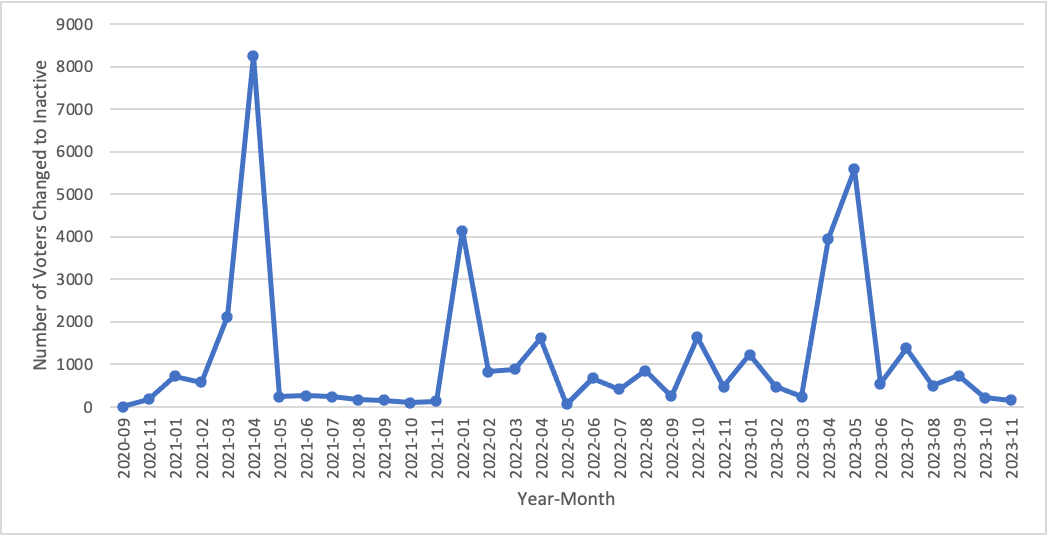
Figure 1. Distribution of actions that reclassified 43,766 voters in the December 2023 Rhode Island Voter Data as inactive between September 2020 and November 2023.
In 2024, Ohio's voter roll averaged 8,090,560 registered voters [5]. In June of that year, state election officials announced plans to remove 158,587 voter registrations as part of its routine list maintenance, establishing a July 22 deadline for affected voters to update their registrations or risk removal [6]. The targeted registrations were flagged for reasons such as voter deaths, relocation, or prolonged non-participation in elections. The names and addresses of the voter registrations slated for deletion were listed on a publicly available website [6]. Four days before the announcement, 82 of the identified registrations were ironically listed as active, while the overwhelming majority—157,331—were classified as inactive [5]. To remain on the voter rolls, impacted voters were required to update their registration details before the deadline or re-register entirely.
This study explores whether text message notifications can effectively prompt inactive and nonresponsive voters—particularly those who remain eligible—to take action to update or maintain their voter registration. By addressing registration issues proactively, this approach has the potential to reduce the administrative burden on election officials, who would otherwise need to process new registrations or last-minute changes at polling places.
For voters, depending on state-specific rules, text messaging may also prevent the frustration of discovering they are not on the voter rolls or encountering unexpected obstacles at the polls—such as being required to cast a provisional ballot that may not be fully counted if it is submitted in the wrong precinct and includes races specific to that location.
Methods
Materials
RI Voter Data. The publicly available Rhode Island Voter Data, observed December 2023 and April 4, 2024, is the source of voter information for the Rhode Island experiment [4]. The December 2023 version of the dataset includes 772,871 voters, of whom 43,766—approximately 6 percent—are marked with an inactive status. These inactive voters serve as the Subjects of the Rhode Island study.
The RI Voter Data includes 50 fields of information, as itemized in Figure 2 . Of these, the fields Status, First Name, City, Date of Status Change, Phone Number, ZIP code, and Year of Birth are used in this study. Values for the Status field are active (“A”), active with NCOA change (“AC”), inactive (“I”), and include two other interim codes.

Figure 2. Fields in the Rhode Island Voter Data of December 2023. Fields used in this study appear in bold.
OH Voter Data. The publicly available Ohio Voter Data, observed June 1 and November 2, 2024, provide the source of voter information for the Ohio experiment [5]. The June 1st version contains 8,481,189 voters with 46 fields of information for each voter. The following fields were used in this study: Voter Registration ID, County, Last name, First name, Date of Birth, Voter Status, Residential Address, Residential City, and Residential ZIP.
OH Announced Drops. In June 2024, Ohio state election officials publicly identified a subset of 158,587 voters in the Ohio Voter Data—by name and address—as scheduled for removal in August as part of their list maintenance [6]. These individuals form the Subjects of the Ohio study.
To analyze these cases, we matched the announced names and addresses against the full OH Voter Data to retrieve corresponding voter registration records. This process yielded 157,413 unique matches, representing 99 percent of the Ohio Subjects. (See [7] for an analysis of these voters beyond this text messaging aspect.)
Text messaging (or SMS) service. VoteFlare.org operates an online service that actively monitors voter registrations in real time, utilizing a sophisticated technical infrastructure designed for timely communications [8]. After a user registers for the service, VoteFlare ensures they are promptly notified via text message if there are any changes to their voter registration that require immediate attention. This study leverages the VoteFlare infrastructure to send SMS notifications to study subjects, ensuring crucial updates are communicated swiftly and effectively [8].
URLs. Text messages sent to Rhode Island voters included links to vote-ri.cc and vota-ri.cc, which redirected users to Rhode Island's official state election websites, vote.ri.gov and vota.ri.gov, respectively. Similarly, messages sent to Ohio voters featured a link to ohiosos.cc, forwarding users to the official Ohio state election website at voterlookup.ohiosos.gov/voterlookup.aspx. These redirects allow for tracking clicks originating from the text messages, confirming the functionality of the service. However, the number of clicks on these links are not a reliable measure of voter response, as individual voters can click multiple times or share the links with others, or visit the state website directly without the link.
Text Message Content. Each Ohio voter who received a text message was sent the following standard message, with <first name> personalized to match the voter’s actual first name.
- “Hi <first name>, Ohio election records indicate your registration will be removed from the Ohio voter roll unless you act now. Please visit ohiosos.cc to update your voter record. [This message is courtesy of the Public Interest Tech Lab at Harvard.]”
In accordance with the script and standards set by Rhode Island election officials, voters in Central Falls, Pawtucket, Providence, and Woonsocket received text messages in both English and Spanish. The English and Spanish versions of the message are provided below. Voters in all other Rhode Island locations received the English version only.
“Hi <first name>, Rhode Island election records indicate you may have moved. Please visit vote-ri.cc or contact your local board of canvassers to view/update your voter record. [This message is courtesy of the Public Interest Tech Lab at Harvard.]”
Hola <first name>, el registro electoral de Rhode Island, indica que es posible que usted se haya mudado. Por favor visite vota-ri.cc o comuníquese con su junta local de elecciones para ver/actualizar su registro de votante. [Este mensaje es cortesía de Public Interest Tech Lab en Harvard.]
Phone Number Lookup Service. VoteFlare employs algorithms that dynamically retrieve phone numbers from data brokers and assign ratings to determine the most reliable phone number for individuals based on their name, address, and year of birth across the United States [8]. This process is based on identifying the primary user of the phone number, regardless of who the official account holder is. Year of birth is used for matching instead of the full date of birth to improve accuracy and avoid common errors often found in full birth dates within large datasets. For this study, VoteFlare's phone number lookup service was utilized. For a detailed list of data brokers that provide phone numbers, please refer to [9][10].
Election dates. The Rhode Island primary election was held on September 10, and the national general election (“Election Day”) was November 5, 2024 [11].
Subjects
As previously described, the”RI Subjects” are voters who were marked as inactive in the Rhode Island Voter Data during 2023, totaling 15,321 individuals. Figure 3 shows the number of voters whose status moved from active to inactive each month, from January through November in 2023. As shown, list maintenance did not occur in a specific month. Instead, some voters changed to inactive status each month, indicating ongoing list maintenance. However, most voters—63 percent of those who became inactive during the year—did so during the months of April and May. This tracking totals 15,011 of the 15,321 RI Subjects because of incomplete or aged information in some of the registrations.
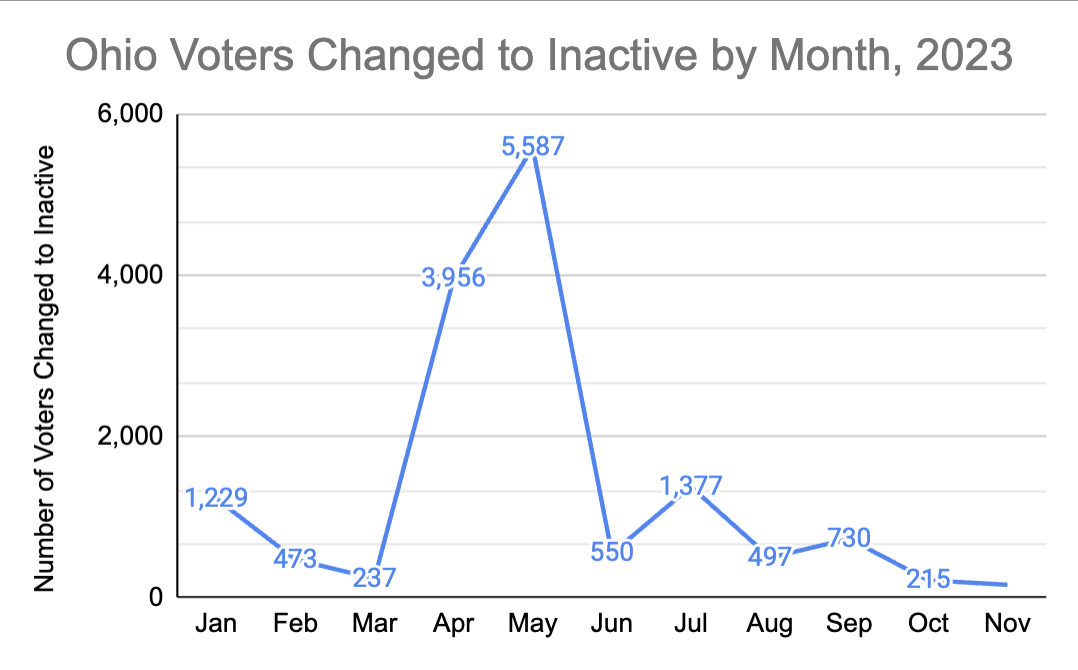
Figure 3. Distribution of changes that switched 15,011 voter registrations of RI Subjects from active to inactive during 2023 in the RI Voter Data. Another 310 voters’ status was changed but could not be tracked by the authors because of incomplete or aged information.
Figure 4 shows the decade of birth for the RI Subjects. Mobility rates are higher among younger adults [12], so we might expect that younger voters would be more likely to become inactive voters. As shown, 53 percent of the inactive voters were born in the 1980s or 1990s.
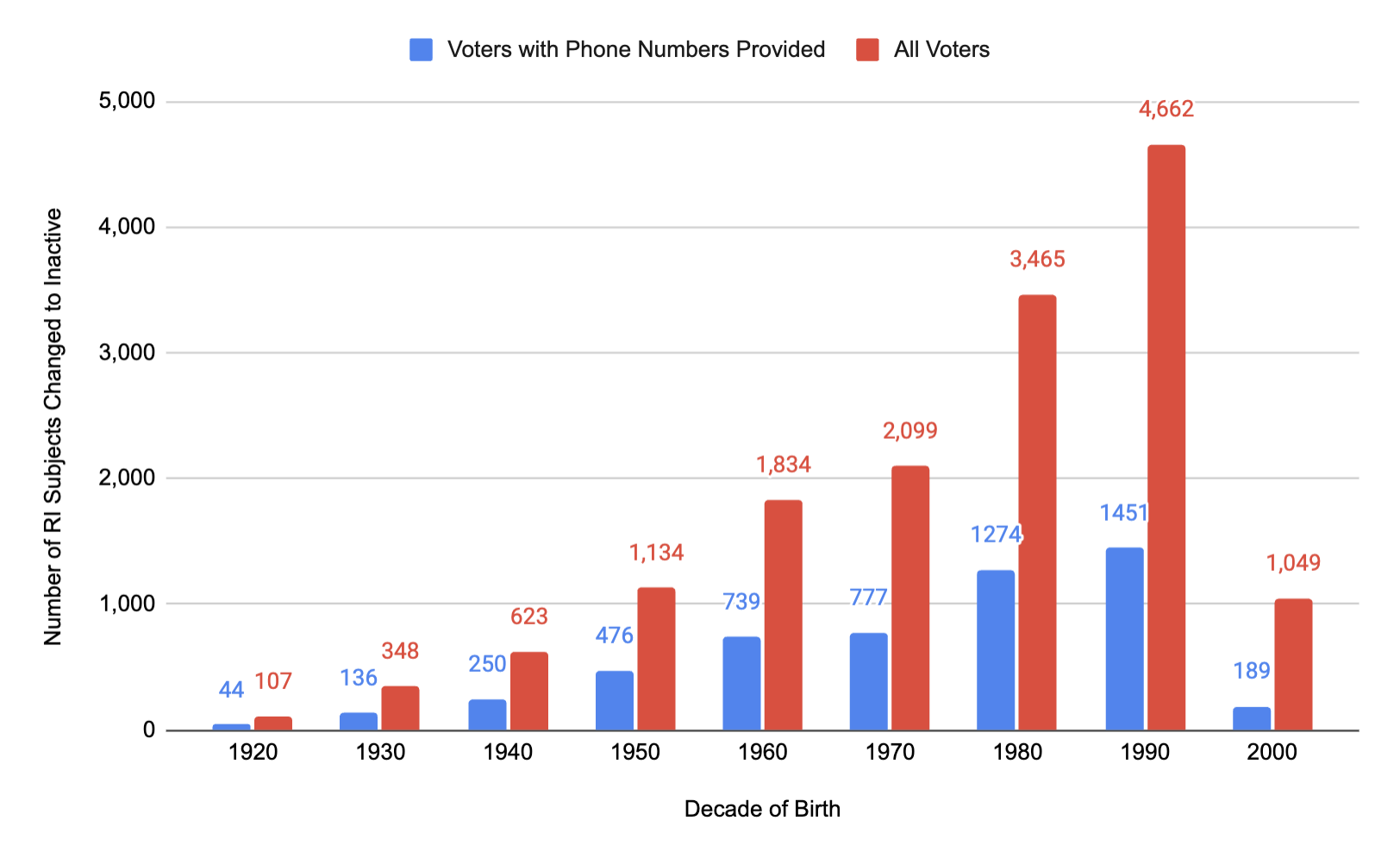
Figure 4. Age and phone number distribution for the 15,321 RI Subjects who became inactive during 2023 in the RI Voter Data. The phone numbers reported are those that were included in RI Voter Data.
As previously noted, the “OH Subjects” are voter registrations that match the names and addresses listed in the Ohio Announced Drops. These Subjects are distributed across 1,047 cities throughout the state.
In 2024, Ohio’s most populous cities—Columbus, Cleveland, Cincinnati, Toledo, and Akron [13]—also account for the highest numbers of subjects. Among them, Cincinnati has the largest share, with 18,214 OH Subjects, representing approximately 11 percent of the total. In contrast, 70 cities had only one identified OH Subject each.
Figure 5 shows the age distribution of OH Subjects. The oldest of the OH Subjects were born in the 1910s, while the youngest were born in the 2000s. The average year of birth is 1974, corresponding to a current age of approximately 50, while the median year is 1980, reflecting a typical age of 44. Notably, there are tall peaks in the distribution for the 1980s and 1990s, which together account for 58 percent of all OH Subjects, representing an average age of about 34 years.
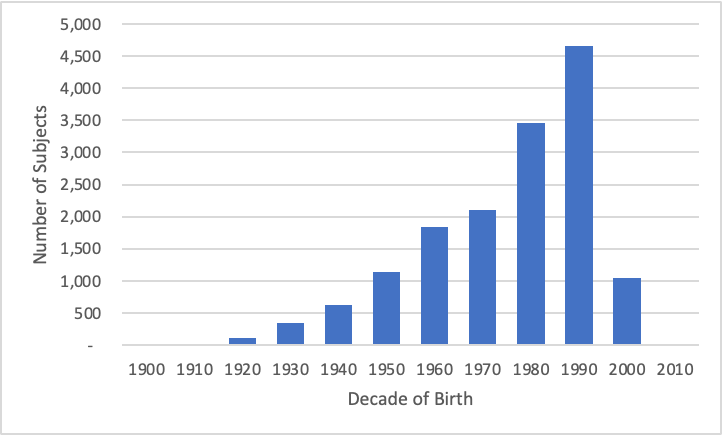
Figure 5. Distribution of birth decade for Subjects in the Ohio data.
Study Design
The study design is straightforward.
Step 0. Identify the Subjects in the voter data.
Step 1. Acquire phone numbers for the identified Subjects.
Step 2. Send the Text Message Content once to each Subject.
Step 3. Receive updated voter data and track the number of registrations associated with the Subjects that reappear in the data with registration updates.
Ethical Considerations for Unsolicited Text Messaging
Reply Handling: All replies to our text messages are recorded. Although the study involves sending only a single message, Subjects can opt out of receiving further messages by replying with "STOP"—ensuring they will not receive additional messages under any circumstances.
Data Collection from Forwards: We collect information from all visits to forwarded URLs. This includes the date and time of the visit, the IP address of the device used, and the browser type.
Accuracy of Recipient: There is a possibility that the recipient of the text message may not be the intended Subject if the phone number is incorrect or shared or has been reassigned. In such cases, the unintended recipient is directed to the state’s website. To proceed further, they must authenticate themselves using information not provided in the text message, ensuring that only eligible individuals can access sensitive actions.
Limitation: Due to the highly polarized nature of the 2024 election and the statewide scope of the voter population involved, our ethical review board required that text messages be sent to all voters capable of receiving them. This constraint introduced a scientific limitation, preventing the use of a standard A/B test design, in which half the eligible subjects would receive the intervention and the other half would serve as a control group.
The concern was that the text message intervention could offer a meaningful benefit, and withholding it from a control group might be ethically comparable to knowingly allowing harm—particularly in the context of an election with irreversible and time-sensitive consequences. While, in retrospect, the treatment effect was not substantial enough to fully justify the concern, the precaution was deemed necessary—particularly given prior and anticipated narrow election margins in Ohio at the time [14][15]. The decision reflects ethical standards similar to those in clinical trials, where withholding a potentially beneficial treatment is not considered acceptable.
This limitation in the study design still permits scientific observation of the proportional impact of text messaging; however, it does not account for potential confounding factors that may influence the observed outcomes.
Benefits to Subjects: Participants benefit from the opportunity to update their voter registration before Election Day. This proactive engagement helps ensure their ability to vote.
Societal Benefits: The study contributes to society by enhancing the accuracy of voter records, reducing barriers for voters and minimizing complications for election workers on Election Day.
Results
Redirects
Traffic from the forwarding URLs demonstrated immediate engagement following the dispatch of text messages, with activity continuing for over a week. Since the text messages were the sole public source of these URLs, the traffic patterns strongly indicate that recipients received and reviewed the messages. For Rhode Island Subjects, the URLs received 1,825 hits between February 2 and February 27. Similarly, for Ohio Subjects, the URLs recorded 24,065 hits between July 3 and July 19.
The use of URL redirects provided a valuable way to verify text message receipt by tracking click activity. However, voters wary of potential scams or those choosing to respond using a laptop or tablet rather than the device that received the text message would search for the official state website directly, bypassing the redirect. So, redirect counts provide a signal of activity but not a full count of visits to the state website from the text message.
Another important consideration when counting URL clicks is that the same voter may have visited the URL multiple times. Additionally, frequent changes in the internet protocol (IP) addresses of mobile devices can result in multiple visits from the same device being recorded as distinct hits. Consequently, the number of URL hits does not directly represent the number of individual voters who responded to a text message.
Rhode Island
Out of the 5,336 phone numbers provided by voters, 752 (14 percent) were invalid, 959 (18 percent) were landlines, and 3,625 (68 percent) were capable of receiving text messages. A detailed breakdown of these numbers is presented in Figure 6 below.
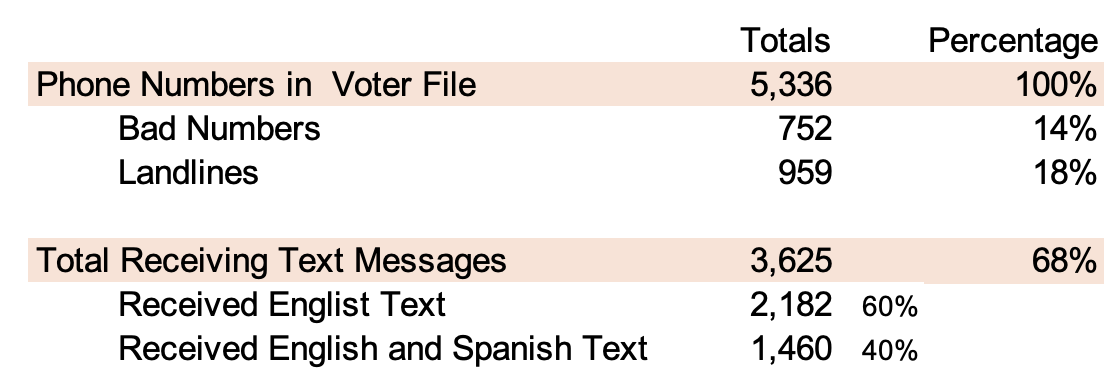
Figure 6. Summary of voter-provided phone numbers for RI Subjects: In total, 3,625 unique phone numbers were capable of receiving text messages, corresponding to 3,671 voter registrations.
On February 2, 2024, the Text Message Content was sent to each of the 3,625 RI Subjects capable of receiving text messages, in accordance with our ethical review requirements. The remaining 11,386 inactive RI Subjects did not receive a text message.
The June 1, 2024, version of the RI Voter Data revealed that the majority of the 15,321 RI Subjects (13,823, or 90 percent) had not made any changes to their registration. This outcome is expected, as these individuals were classified as inactive voters. However, 1,498 voters (10 percent) did take corrective action to update their registration. Among those who took corrective action, there are two distinct groups: those who received the text message and those who did not.
A total of 395 (11 percent) of the 3,625 Rhode Island voters who received the text message had updated active registrations, compared to 1,103 (9 percent) of the 11,650 who did not receive a message—a statistically significant difference at the 5 percent level. However, 25 of those 395 updates were made by election officials through routine list maintenance using the National Change of Address program during the same month as the experiment, making voter response unclear—a voter may have visited the website in response to the text message and taken no further action upon seeing the updated status, or depending on the operation of the system and timing of the changes, a user’s update may have been overwritten. Excluding those 25 cases, we conservatively attribute 370 updates (10 percent) to confirmed voter action—a modest improvement over 9 percent, though not statistically significant. Altogether the impact of the text message may lie between 10 and 11 percent, though precise attribution is blurred by administrative processes. Figure 7 summarizes these findings.

Figure 7. Comparison of previously unresponsive RI Subjects who received SMS (text) messages to the phone number they provided on their voter registration and updated their registrations by June 1, versus those who did not receive a text message at a user-provided number.
About 53 percent of the Rhode Island Subjects were born in the 1980s and 1990s (see Figure 4), so it is not surprising that the average year of birth is relatively consistent across groups. Regardless of whether Subjects responded to the text message or updated their registration without receiving one, the average year of birth generally falls between 1979 and 1981. Figure 8 provides descriptive statistics on year of birth across these groups.
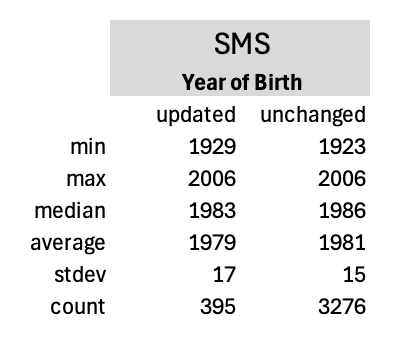 |
 |
| (a) |
(b) |
Figure 8. Descriptive statistics on the year of birth of (a) RI Subjects in the SMS group and (b) the no-SMS group.
Ohio
Of the 158,857 Ohio Subjects, the Phone Number Lookup Service returned phone numbers for 125,067 individuals (79 percent) based on name and address matches. Of these, 119,045 (75 percent of all OH Subjects) were matched using name, address, and year of birth with mobile lines capable of receiving text messages.
On July 3, 2024, each of the 119,045 OH Subjects received the Text Message Content in a single SMS message.
Among the Ohio voters who received a text message at a phone number matched to their name and year of birth, 5,403 out of 119,045 (5 percent) remained on the voter rolls by Election Day. In comparison, only 1,468 out of 39,812 (4 percent) who did not receive the message were still on the rolls. Although the difference between 5 percent and 4 percent might appear small, it is statistically significant at the 5 percent level—meaning that there is a high level of confidence (at least 95 percent) that this result was not due to random chance. This suggests the text message had a measurable impact on voter retention. See Figure 9 for details.

Figure 9. Comparison of OH Subject registration statuses on Election Day of previously unresponsive Subjects for those who received a single SMS message at a phone number associated with their name and year of birth versus those who did not receive the text message.
Overall, 6,871 OH Subjects were registered by Election Day. Of these, 5,403 (79 percent) had received the SMS text message, while the remaining 1,468 (21 percent) had not.
As reported earlier, the average year of birth among OH Subjects is 1974, corresponding to a current average age of approximately 50. However, a closer look reveals that 58 percent of all OH Subjects were born in the 1980s and 1990s (see Figure 5), having ages of approximately 40 and 30, respectively. Among those who received the text message, the average year of birth was 1981 for voters who updated their registration, compared to 1980 for those who did not. In contrast, among those who did not receive the message, the average year of birth was 1975 for voters who updated their registration, and 1977 for those who did not. These findings suggest that younger voters in Ohio were more able to receive and act in response to the text message intervention. Figure 10 presents descriptive statistics on the ages of these groups.
 |
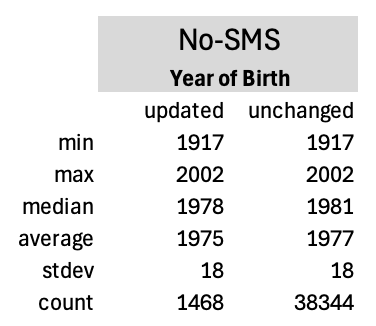 |
| (a) |
(b) |
Figure 10. Descriptive statistics on the year of birth of (a) RI Subjects in the SMS group and (b) the no-SMS group.
The findings in these Rhode Island and Ohio experiments indicate that previously unresponsive Subjects who received a single SMS text message at either a phone number they provided or one associated with their name and full year of birth were more likely to update their registrations and remain on the voter rolls by Election Day compared to those who did not receive a message.
Discussion
It is often assumed that voters unresponsive to mailings or disengaged in prior elections may have moved, passed away, or become ineligible to vote within the jurisdiction. However, our findings reveal that many eligible voters who were previously unresponsive to postal notices do respond to a single text message, taking corrective action to update their registration in time to vote.
While these results are promising, they raise important questions about the broader effectiveness of text messaging for voter registration and maintenance. For instance, does sending multiple text messages increase voter response rates? What is the optimal timing for sending messages relative to an election? How does email response compare to text messaging? Does a reliance on email or text messaging introduce any fairness issues with income or age? Additionally, since many unresponsive voters may have relocated to another state, our findings do not account for whether the text messages prompted them to register in their new jurisdiction.
Our study design ethics required sending text messages to all subjects with reasonably identified phone numbers because this was the first known experiment of its kind and because of the politically tense nature of the election. Moving forward, our findings highlight the need for a more rigorous study design that randomly assigns subjects to receive or not receive text messages, enabling a comparison of outcomes between the groups that accounts for various possible confounders. This approach could provide more definitive evidence of the impact of text messaging interventions on voter registration behavior.
Another methodological issue to examine in future work is the use of the redirect URL. Recipients may have been concerned with the link being associated with spam, mischief, or just unsafe behavior. Apple iPhones have a security feature that, if enabled, prohibits a tap on unknown links to access websites [16]; recipients in this case would have to copy the link to a browser to view. Do voters respond differently to recognizable state URLs?
Our findings suggest that voters can be responsive to text messages regardless of whether they provided their phone number directly to the election office or if the number was reliably sourced through a data broker. However, an important question remains: Are voters who voluntarily provide their phone numbers more likely to respond to text messages about their voter registration than those whose numbers were obtained externally?
The results from these experiments highlight the potential for election officials to utilize modern communication methods to overcome the limitations of traditional voter outreach, such as undeliverable mail. Text messaging offers a highly cost-effective alternative, with the cost of transmitting a single message being less than 10 cents at scale, compared to 73 cents for a postal stamp. Even a single text message can drive significant corrective action, as demonstrated by the improvements in voter registration updates observed in both Rhode Island and Ohio.
Acknowledgments
The authors extend their sincere gratitude to Pascal Delpe-Brice, Mamoun Janfor, Joshua Shank, and the members of the Public Interest Tech Lab for generously dedicating their time to review, assist, and provide thoughtful feedback on these experiments. We also thank VoteFlare.org at the Public Interest Tech Lab at Harvard for providing access to its technological infrastructure, which made this work possible. Additional thanks go to editors at TechScience and to the students and teaching staff in Harvard’s DPI-642 and Gov 1430 courses during the Spring 2025 semester for their valuable comments and insights. Finally, we are grateful to the Bloomberg Center for Cities for their support.
References
- Civil Rights Division, "The National Voter Registration Act OF 1993 (NVRA)," U.S. Department of Justice, 1 November 2024. [Online]. Available: https://www.justice.gov/crt/national-voter-registration-act-1993-nvra. [Accessed 27 January 2025].
- A. Smith, "Americans and Text Messaging," Pew Research Center, 19 September 2011. [Online]. Available: https://www.pewresearch.org/internet/2011/09/19/americans-and-text-messaging/. [Accessed 27 January 2025].
- Trumpia Blog, "30 SMS Texting Statistics That'll Blow Your Mind," 25 June 2022. [Online]. Available: https://blog-inside.trumpia.com/30-sms-marketing-statistics/. [Accessed 27 January 2025].
- Rhode Island Department of State, "Rhode Island Voter Registration Form," [Online]. Available: https://vote.sos.ri.gov/Forms/elections/Forms/VoterRegFormEng.pdf. [Accessed 27 January 2025].
- Ohio Secretary of State, "Voter Files Download Page," [Online]. Available: https://www6.ohiosos.gov/ords/f?p=VOTERFTP:HOME. [Accessed 27 January 2025].
- Ohio Secretary of State, "Registration Readiness," [Online]. Available: https://registrationreadiness.ohiosos.gov/. [Accessed 27 January 2025].
- e. a. L. Sweeney, "Voter List Maintenance and the Erroneous Removal Rate of Ohio's 2024 Announced Deletions," Journal of Technology Science, April 2025.
- L. S. e. al, "VoteFlare," Public Interest Tech Lab, [Online]. Available: https://voteflare.org/. [Accessed 27 January 2025].
- J. Y. a. J. Z. L. Sweeney, "Voter identity Theft: Submitting Changes to Voter Registrations Online to Disrupt Elections," Journal of Technology Science, 5 September 2017.
- World Privacy Forum, "Data Brokers Opt Out List," January 2018. [Online]. Available: https://www.worldprivacyforum.org/2013/12/data-brokers-opt-out/. [Accessed 27 January 2025].
- Rhode Island Secretary of State, "Rhode Island 2024 Election Calendar," [Online]. Available: https://vote.sos.ri.gov/Forms/Elections/Guides/24ElecCalEng.pdf. [Accessed 25 January 2025].
- R. Frost, "Are Americans Stuck in Place? Declining Residential Mobility in the US," May 2020. [Online]. Available: https://www.jchs.harvard.edu/sites/default/files/harvard_jchs_are_americans_stuck_in_place_frost_2020.pdf. [Accessed 30 January 2025].
- K. Carney, "Ohio Cities by Population (2025)," Ohio Demographics by Cubit, 17 December 2024. [Online]. Available: https://www.ohio-demographics.com/cities_by_population. [Accessed 30 January 2025].
- 270 To Win, "Ohio Presidential Election Voting History," [Online]. Available: https://www.270towin.com/states/ohio. [Accessed 30 January 2025].
- WBNS, "Ohio 2024 Primary Election Voter Guide: What's on the ballot, where to vote, polling hours," 19 March 2024. [Online]. Available: https://www.10tv.com/article/syndication/ohio-primary-election-2024-ballot-voter-guide/530-5878339f-fc7f-41d5-93e1-903df9284aed. [Accessed 30 January 2025].
- R. Heimann, "iPhone Text/SMS URL Not Hyperlinked? Here's the Fix," Haystack, [Online]. Available: https://help.thehaystackapp.com/en/articles/5185709-iphone-text-sms-url-not-hyperlinked-here-s-the-fix. [Accessed 30 March 2025].
Authors
Latanya Sweeney is Professor of the Practice of Government and Technology at the Harvard Kennedy School and in the Harvard Faculty of Arts and Sciences, director and founder of the Public Interest Tech Lab and the Data Privacy Lab at Harvard, and former Chief Technology Officer at the U.S. Federal Trade Commission. Latanya Sweeney has 3 patents, more than 100 academic publications, pioneered the field known as data privacy, launched the emerging area known as algorithmic fairness, and her work is explicitly cited in two U.S. regulations. She earned her PhD in computer science from MIT. Dr. Sweeney creates and uses technology to assess and solve societal, political and governance problems, and teaches others how to do the same. More information is available at her website, latanyasweeney.org.
Josh Visnaw is an advocacy, policy, and political strategist who has worked in
several roles in campaigns, community engagement, and international
development. Josh has experience across 11 states, including recent
campaign roles for the Wisconsin Democratic Party in 2020, Bernie 2020,
Michigan Democratic Party in 2018, and Bernie 2016. His international experiences include managing development projects in
Central America and Southeast Asia, including work with Belize’s Ministry of
Education and Timor-Leste’s Ministry of Youth and Labor. As a Fulbright Public
Policy Fellow in Timor-Leste, he advised government officials on issues
relating to youth participation in democracy and civil society. He also
completed a consultancy for the Food and Agriculture Organisation of the
United Nations, producing a study on improving livelihoods for rural youth.
Citation
Sweeney L. and Visnaw J.
Efficacy of Text Messaging in Activating Hard-to-Reach Voters in Rhode Island and Ohio.
Technology Science.
2025041701.
April 22, 2025.
https://techscience.org/a/2025041701/
Suggestions (0)
Click the below button to open the suggestions form in a new tab.
Enter your recommendation for follow-up or ongoing work in the box at the end of the page.
Feel free to provide ideas for next
steps, follow-on research, or other research inspired by this paper.
Perhaps someone will read your
comment, do the described work, and publish a paper about it. What do
you recommend as a next research step?
Submit Suggestion on MyPrivacyPolls
Back to Top












